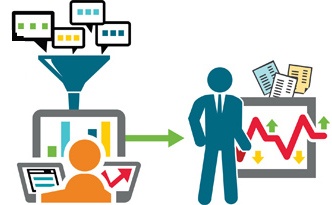When it comes to industries best poised for big changes with the big data wave, content providers - including all types of news media - have a lot to gain and a relatively straightforward path to get there because the very act of consuming content provides so much valuable data.

Every time a user reads, listens to, or watches content, of course, is a simple indication of preference. But leveraging AI to get ahead is also about analyzing the details, including when users re-read, fast forward, stop consuming (and at what point they do so), share, and more.
These more subtle and detailed signals communicate even more interesting insight about users’ preferences and can aid automatic optimization by improving the types of content and advertisements served to customers and the way that content gets consumed (think layout or UX). With data storage costs dropping significantly in recent years, choosing exactly what data to collect is no longer a concern. Instead, the concern lies in seeing a return on the vast amounts of data being collected.

The challenge in AI for media organizations lies in using vast amounts of data for real business impact.
From Basic to Advanced
But even these more basic signals on user preference and content optimization are just the beginning and really represent the baseline of big data use in media today. Huge opportunity exists in the area of advanced analytics, including applying deep learning to unstructured data, which makes up the large majority of media companies’ datasets (photos, videos, and blocks of text). This data can be used to further optimize content (and advertisement) creation or recommendation.
Predictive analytics is also an opportunity, specifically when it comes to building and keeping a subscriber base - something that is a huge challenge for all media companies today. Anticipating and targeting those who are likely to become subscribers or likely to end their subscription is an extraordinarily valuable first step to growing and keeping users.

The New York Times spoke about their transition to big data and predictive analytics a few years ago, and they notably have managed to increase subscribers even during tumultuous times for news media. A churn prediction project is a great place to get started with predictive analytics - we’ve recently published a guide to help.
Social media can also provide valuable insight into trending topics both locally and globally, something that predictive analytics can uncover and help companies ensure adequate and timely coverage. That’s just one way that businesses can leverage a trove of external data from Twitter and other sources - read about more use cases for social media data.
Take Action
So yes, there is lots of data out there. But often it’s deciding what to do with all the data, making sense of it, then actually taking action based on it that’s challenging for media companies today. The first step is choosing a relevant use case.
In addition to the use cases discussed above, media organizations also are using big data, machine learning (including deep learning) and predictive analytics for:
- Comment management/authentication
- Content planning and direction
- Useful data visualizations, like where subscribers live or consumption habits of top subscribers
- Automating the actual creation of news stories, both text or video (e.g., taking stats from a baseball game and using machine learning to auto-generate a story surrounding it)
- Conducting data journalism, or a way to distill large data sets in meaningful (and, more importantly, accurate) ways to tell a story




